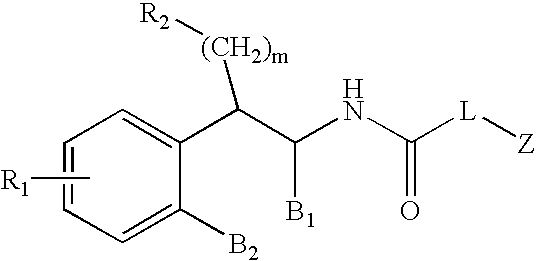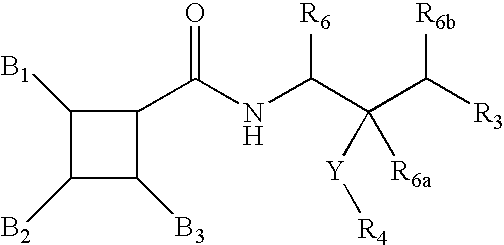Diphenyl cyclopentyl amides as cannabinoid-1 receptor inverse agonists
a technology of cannabinoid-1 receptor and cyclopentyl amide, which is applied in the direction of biocide, drug composition, metabolic disorder, etc., can solve the problems of overeating, psychosis, memory loss, and sedation
- Summary
- Abstract
- Description
- Claims
- Application Information
AI Technical Summary
Benefits of technology
Problems solved by technology
Method used
Image
Examples
reference example 1
[0801]
N-[2,3-Bis(4-chlorophenyl)-1-methylpropyl]-amine hydrochloride
[0802]The preparation of the two diastereomers (alpha and beta) of N-[2,3-bis(4-chlorophenyl)-1-methylpropyl]-amine hydrochloride salt has been disclosed (Schultz, E. M, et al. J. Med Chem. 1967, 10, 717). Diastereomer α: LC-MS: calculated for C16H17Cl2N 293, observed m / e 294 (M+H)+ (retention time 2.5 min). Diastereomer β: LC-MS: calculated for C16H17Cl2N 293, observed m / e 294 (M+H)+ (retention time 2.2 min).
reference example 2
[0803]
N-[3-(4-Chlorophenyl)-2-phenyl-1-methylpropyl]-amine hydrochloride (Diastereomer α)
Step A 3-(4-Chlorophenyl)-2-phenylpropanoic acid, methyl ester
[0804]To a solution of methyl phenylacetate (12 g, 80 mmol) and 4-chlorobenzyl bromide (16 g, 80 mmol) in 250 mL of anhydrous tetrahydrofuran at −78° C. was added sodium hexamethyldisilazide (1 M in tetrahydrofuran, 80 mL, 80 mmol) (potassium hexamethyldisilazide in toluene may be used with similar results). The reaction was allowed to warm to room temperature overnight. The volatile materials were removed on a rotary evaporator, and the resulting mixture was partitioned between saturated ammonium chloride (200 mL) and ethyl acetate (200 mL). The organic layer was separated and the aqueous layer extracted with ethyl acetate (2×200 mL). The combined organic extracts were dried over anhydrous sodium sulfate, filtered, and concentrated to dryness to give the title compound. 1H NMR (500 MHz, CD3OD): δ 7.36-7.10 (m, 9H), 3.81 (dd, 1H), 3.5...
reference example 3
[0813]
N-[3-(4-Chlorophenyl)-2(S)-phenyl-1(S)-methylpropyl]-amine hydrochloride
Step A 4-(4-Chlorophenyl)-3(S)-phenyl-2(R)-butanol
[0814]A sample of magnesium (20 g, 0.82 mol) was activated by stirring under nitrogen for 12 h, and anhydrous ether (100 mL) was added to cover the solid material. The mixture was cooled to 0° C., and 4-chlorobenzyl chloride (40 g, 0.25 mmol) in 400 mL of anhydrous ether was added dropwise. After stirring at room temperature for 1 h, a sample of the above solution (32 mL) was added to (1R,2R)-1-phenylpropylene oxide (1.0 g, 7.5 mmol) in 100 mL of ether at 0° C. via syringe. After stirring at 0C for 2 h, the reaction was quenched by addition of saturated aqueous ammonium chloride (100 mL. The organic layer was separated and the aqueous layer extracted with ether (2×100 mL). The combined organic extracts were washed with brine, dried over anhydrous magnesium sulfate, filtered, and concentrated to dryness, and the residue was purified by flash column chromatog...
PUM
| Property | Measurement | Unit |
|---|---|---|
| body weight | aaaaa | aaaaa |
| body weight | aaaaa | aaaaa |
| body weight | aaaaa | aaaaa |
Abstract
Description
Claims
Application Information
 Login to View More
Login to View More - R&D
- Intellectual Property
- Life Sciences
- Materials
- Tech Scout
- Unparalleled Data Quality
- Higher Quality Content
- 60% Fewer Hallucinations
Browse by: Latest US Patents, China's latest patents, Technical Efficacy Thesaurus, Application Domain, Technology Topic, Popular Technical Reports.
© 2025 PatSnap. All rights reserved.Legal|Privacy policy|Modern Slavery Act Transparency Statement|Sitemap|About US| Contact US: help@patsnap.com



